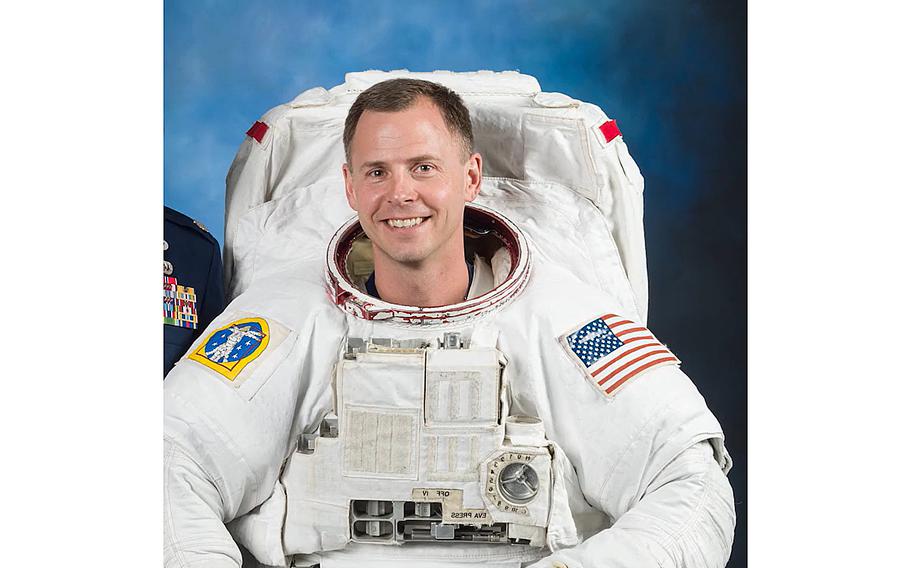
A video screen grab shows Space Force Col. Nick Hague as seen in his astronaut suit in October 2018 when he was part of the Air Force Space Command. (U.S. Air Force/NASA)
(Tribune News Service) — NASA announced the four members for the planned August SpaceX mission to rotate crew on the International Space Station and it includes the first member of the U.S. Space Force flying to orbit.
The crew member, which Space Force calls a guardian, has already been to space, but for NASA as a member of the Air Force.
Piloting the SpaceX Crew-9 flight will be U.S. Space Force Col. Nick Hague, who previously had a scary initial ride the Air Force technically considered having reached space in 2018 that ended with an abort. It happened as he and a Russian crewmate cosmonaut Alexey Ovchinin aboard a Soyuz capsule blasted away from a malfunctioning booster after launch from Kazakhstan.
“It went from normal to something was wrong pretty quick,” he said after the abort. “We weren’t going to make it to orbit that day, so the mission changed to getting back down on the ground as safely as we could.”
The altitude of the Soyuz capsule passed the 50-mile mark the U.S. considers for awarding astronaut status, although it’s shy of the Karman line, which is the internationally recognized line for having made it to space at around 62 miles high.
“I got to experience a few seconds of weightlessness and I was able to watch a few things float around in the capsule,” he said. “I was also able to look out the window primarily to make sure, ‘Hey, are we in a good attitude? Are we stable? Are we ready to come back down?’ But also to look out the window and realize, you know, looking down at the curvature of the Earth and out into the blackness of space, and realizing I got close but it wasn’t going to be this time.”
The duo got another shot, though, five months later in 2019, and that time they made it past the Karman line along with NASA astronaut Christina Koch. Hague spent more than 200 days on board the ISS. So Crew-9 will be his third or second flight to space depending on who you ask.
Commanding the Crew-9 flight will be rookie Zena Cardman, a member of the astronaut candidate class of 2017 that was nicknamed “The Turtles” by the astronaut class that preceded them.
She will be the 10th Turtle to make it space following Crew-8’s upcoming flight targeting late February taking up classmate Matthew Dominick. That leaves only one Turtle without an space assignment yet — Jonny Kim — although he was named among the original Artemis astronaut candidates.
Also flying will be NASA astronaut and mission specialist Stephanie Wilson, who flew three times on Space Shuttle Discovery on STS-121, STS-120, and STS-131 logging 42 days in space, and Roscomos cosmonaut and mission specialist Aleksandr Gorbunov, making his first trip to space.
The quartet will spend about six months on board the station as part of Expeditions 71 and 72 to be relieved by either a SpaceX or possibly Boeing Starliner mission in early 2025.
Hague’s return in 2019 led him to a post-flight role at the Pentagon with the Air Force, but working as leadership as director of test and evaluation for the newly formed Space Force. In 2021, Hague transferred from the Air Force to the Space Force, which at just over four years old now has about 14,000 military and civilian Guardians. Since August 2022, Hague has been back with NASA working on the Starliner program.
Roughly two-thirds of NASA astronauts have served in the U.S. Armed Forces.
“Being a part of this mission is a unique honor, but it’s truly a collective effort,” Hague said in a Space Force press release. “Guardians worldwide ensure safe and secure operations of critical systems for launch and on station.”
The ISS has been continuously populated since November 2020, first by alternating crews from the Space Shuttle Program and Souyz launches from Russia. After the shuttles stopped flying in 2011, it took nearly nine years before SpaceX restarted human spaceflight to the ISS from the U.S. with the Demo-2 mission in May 2020.
Since then SpaceX has flown 46 humans to orbit on its fleet of Crew Dragon spacecraft including seven operational flights to the ISS for NASA and its ISS partners. It’s also sent up three private missions for Axiom Space to the ISS.
A good portion of them are on the station right now, which has a population of 11 for now.
Right now both the Crew Dragon Endurance and Freedom are docked to the ISS as the four members of Crew-7 that arrived last August were joined earlier this month by the four members of the Axiom 3 mission.
Their departure and the arrival of replacement crews mark a busy first half of 2024 for the station.
The Ax-3 crew will climb aboard Crew Dragon Freedom as early as Saturday for their ride home to splash down off the coast of Florida while Crew-7 will await the arrival of Crew-8 that’s slated for a late February launch from Kennedy Space Center before they make their return trip as well. A replacement Soyuz crew is slated to arrive in March.
And then in April, the first crewed test flight of Starliner is slated to launch from Cape Canaveral on an Atlas V to send up a pair of NASA astronauts for a short stay in Boeing’s efforts to join SpaceX as regular flight providers under NASA’s Commercial Crew Program.
©2024 Orlando Sentinel.
Visit orlandosentinel.com
Distributed by Tribune Content Agency, LLC.